
Java程序设计基础教学大纲 Java Programming Fundamentals Subject Syllabus 一、课程信息Subject Information 课程编号: 开课学期: 3100213001 Subject ID Semester 2 课程分类: 所尾课雅 专业教有PA 专业基础MF egory e 课程学分: 总学时周 32/4 Credit Points Total Hours/Weeks 理论学时 实验学时 LECT HOUr 32 EXP HOur 0 PBL学时 0 实践学时/周 PBL Hours PRAC.Hours/Weeks 0 开课学院 东北大学 适用专业: 计算机科学与技术 悉尼智能科技学院 Stream CST 课程属性 选修Elective 课程模式 自建NEU Pattern Mode 中方课程协调人 NEU Coordinator 万聪 成绩记载方式: 百分制Marks Result Type 无none 英文参考教材 Java An introduction to problem solving and programming.Walter Savitch and Kenrick Mock EN Textbooks 中文参考教材 Java程序设计与问题求解,机械工业出版社,2019 CN Textbooks 教学资源: Resources ttps://docs.oracle.com/javase/tutorial/ 课程负责人(撰写人) 万聪 提交日期 Submitted Date 3/4/2023 Subject Director 任课教师(含负责人 万聪 Taught by 宙核人 Checked by 韩鹏 批准人: 史闻博 Approved b 批准日期: 单击或点击此处输 Approved Date 入日期。 1113
1 / 13 Java 程序设计基础 教学大纲 Subject Syllabus Java Programming Fundamentals 一、课程信息 Subject Information 课程编号: Subject ID 3100213001 开课学期: Semester 2 课程分类: Category 专业教育 PA 所属课群: Section 专业基础 MF 课程学分: Credit Points 2 总学时/周: Total Hours/Weeks 32/4 理论学时: LECT. Hours 32 实验学时: EXP. Hours 0 PBL 学时: PBL Hours 0 实践学时/周: PRAC. Hours/Weeks 0 开课学院: College 东北大学 悉尼智能科技学院 适用专业: Stream 计算机科学与技术 CST 课程属性: Pattern 选修 Elective 课程模式: Mode 自建 NEU 中方课程协调人: NEU Coordinator 万聪 成绩记载方式: Result Type 百分制 Marks 先修课程: Requisites 无 none 英文参考教材: EN Textbooks Java An introduction to problem solving and programming, Walter Savitch and Kenrick Mock 中文参考教材: CN Textbooks Java 程序设计与问题求解,机械工业出版社,2019 教学资源: Resources https://docs.oracle.com/javase/tutorial/ 课程负责人(撰写人): Subject Director 万聪 提交日期: Submitted Date 3/4/2023 任课教师(含负责人): Taught by 万聪 审核人: Checked by 韩鹏 批准人: Approved by 史闻博 批准日期: Approved Date 单击或点击此处输 入日期
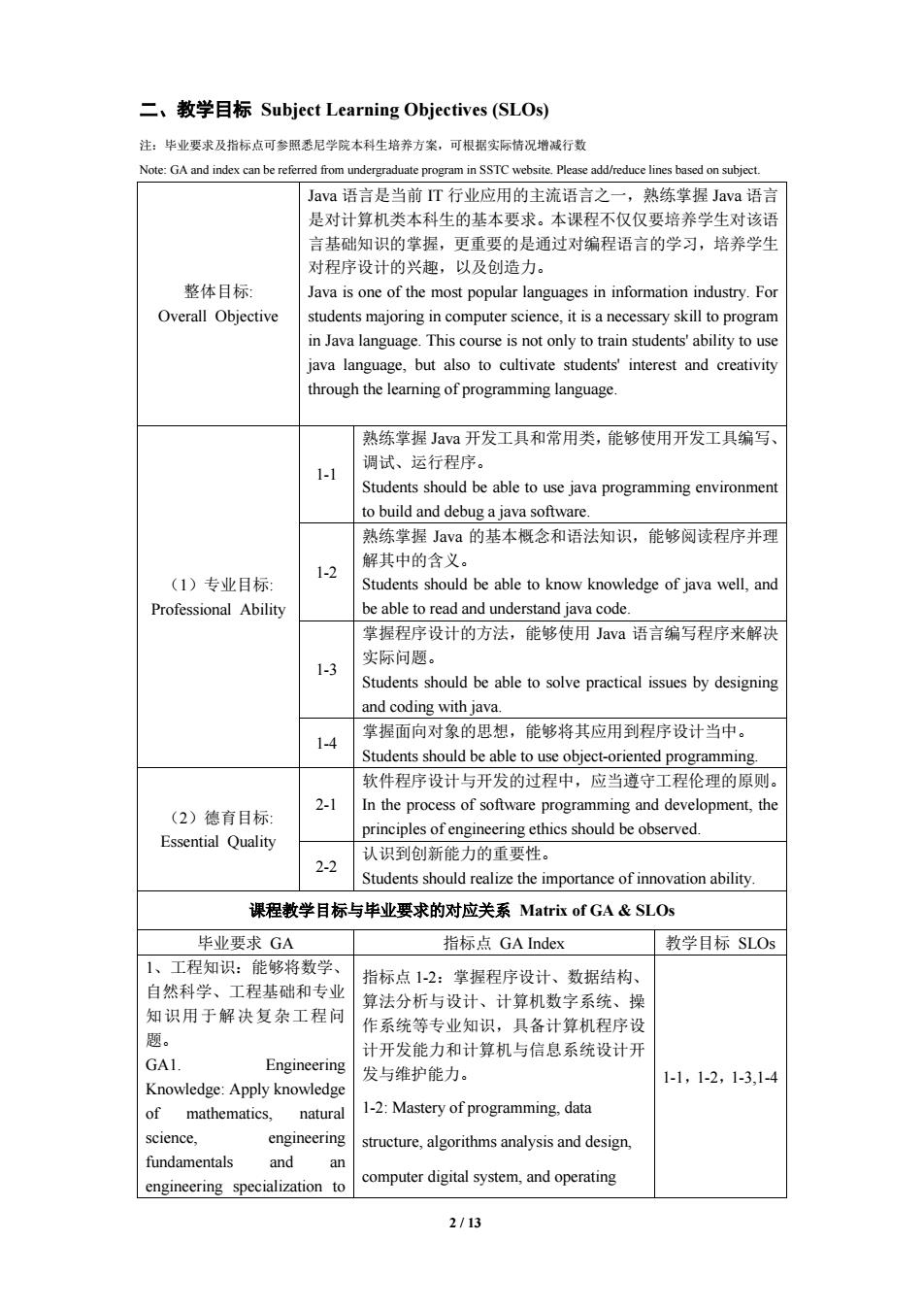
二、教学目标Subject Learning Objectives(SLOs) 注:毕业要求及指标点可参照悉尼学院本科生培养方案,可根据实际情况增减行数 Note:GA and index can be referred from undcreraduate program in SSTC website.Please add/reduce lines hased on subicc Java语言是当前T行业应用的主流语言之一, 熟练掌握Java语言 是对计算机类本科生的基本要求。本课程不仅仅要培养学生对该语 言基础知识的掌握,更重要的是通过对编程语言的学习,培养学生 对程序设计的兴趣,以及创造力。 整体目标 Java is one of the most popular languages in information industry.For Overall Objective dents majoring incomputers it is a necessary sil t o progra in Java language.This course is not only to train students'ability to us iava language.but also to cultivate students'interest and creativity through the leaming of programming language. 熟练掌握Java开发工具和常用类,能够使用开发工具编写 调试、运行程序 Students should be able to use java programming environment to build and debug a iava software 熟练掌握Java的基本概念和语法知识,能够阅读程序并理 (1)专业目标 1-2 解其中的含义。 Students should be able to know knowledge of java well,and Professional Ability be able to read and understand java code. 掌握程序设计的方法,能够使用Java语言编写程序来解决 实际问题。 1-3 Students should be able to solve practical issues by designin and coding with java 1-4 掌握面向对象的思想,能够将其应用到程序设计当中。 Students should be able to use object-oriented programming 软件程序设计与开发的过程中,应当遵守工程伦理的原则。 (2)德有目标 2-1 In the process of software programm Essential Quality principles ofengineering ethics should be observed. 2-2 认识到创新能力的重要性。 Students should realize the importance of innovation ability 课程敦学目标与毕业要求的对应关系Matrix of GA&SLOs 毕业要求GA 指标点GA Index 教学目标SLOs 1、工程知识:能够将数学、 自然科学、工程基础和专业 指标点12:掌握程序设计、数据结构、 算法分析与设计、计算机数字系统、扬 知识用于解决复杂工程问 作系统等专业知识,具备计算机程序设 题。 计开发能力和计算机与信总系统设计于 GAL Engineering 发与维护能力。 Knowledge:Apply knowledge 1-1,1-2,1-3,1-4 of mathematics. natural 1-2:Mastery of programming.data engineering structure,algorithms analysis and design, fundamentals and engineering specialization to computer digital system,and operating 2113
2 / 13 二、教学目标 Subject Learning Objectives (SLOs) 注:毕业要求及指标点可参照悉尼学院本科生培养方案,可根据实际情况增减行数 Note: GA and index can be referred from undergraduate program in SSTC website. Please add/reduce lines based on subject. 整体目标: Overall Objective Java 语言是当前 IT 行业应用的主流语言之一,熟练掌握 Java 语言 是对计算机类本科生的基本要求。本课程不仅仅要培养学生对该语 言基础知识的掌握,更重要的是通过对编程语言的学习,培养学生 对程序设计的兴趣,以及创造力。 Java is one of the most popular languages in information industry. For students majoring in computer science, it is a necessary skill to program in Java language. This course is not only to train students' ability to use java language, but also to cultivate students' interest and creativity through the learning of programming language. (1)专业目标: Professional Ability 1-1 熟练掌握 Java 开发工具和常用类,能够使用开发工具编写、 调试、运行程序。 Students should be able to use java programming environment to build and debug a java software. 1-2 熟练掌握 Java 的基本概念和语法知识,能够阅读程序并理 解其中的含义。 Students should be able to know knowledge of java well, and be able to read and understand java code. 1-3 掌握程序设计的方法,能够使用 Java 语言编写程序来解决 实际问题。 Students should be able to solve practical issues by designing and coding with java. 1-4 掌握面向对象的思想,能够将其应用到程序设计当中。 Students should be able to use object-oriented programming. (2)德育目标: Essential Quality 2-1 软件程序设计与开发的过程中,应当遵守工程伦理的原则。 In the process of software programming and development, the principles of engineering ethics should be observed. 2-2 认识到创新能力的重要性。 Students should realize the importance of innovation ability. 课程教学目标与毕业要求的对应关系 Matrix of GA & SLOs 毕业要求 GA 指标点 GA Index 教学目标 SLOs 1、工程知识:能够将数学、 自然科学、工程基础和专业 知识用于解决复杂工程问 题。 GA1. Engineering Knowledge: Apply knowledge of mathematics, natural science, engineering fundamentals and an engineering specialization to 指标点 1-2:掌握程序设计、数据结构、 算法分析与设计、计算机数字系统、操 作系统等专业知识,具备计算机程序设 计开发能力和计算机与信息系统设计开 发与维护能力。 1-2: Mastery of programming, data structure, algorithms analysis and design, computer digital system, and operating 1-1,1-2,1-3,1-4
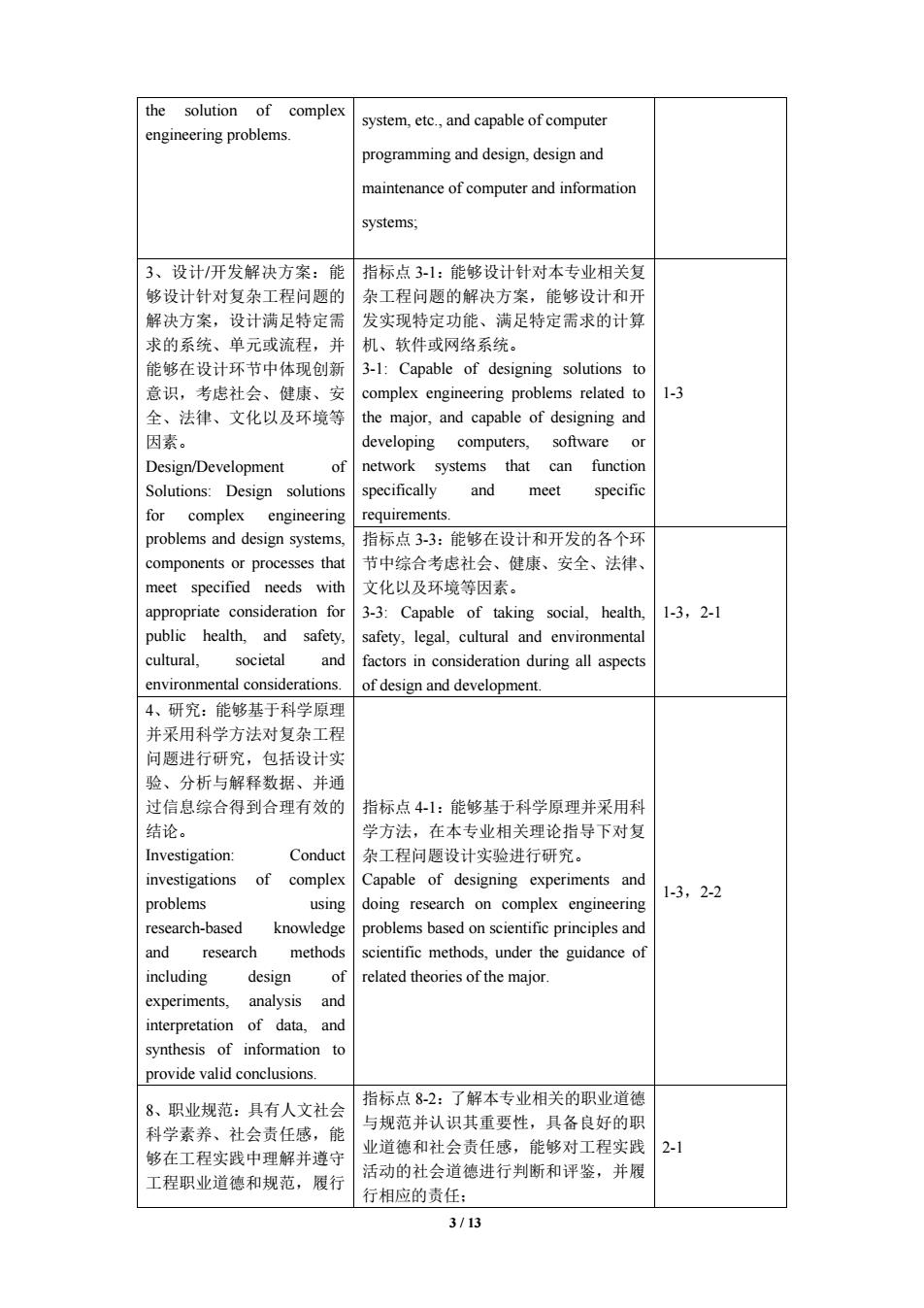
the solution of complex engineering problems. system,etc.,and capable of computer programming and design,design and maintenance of computer and information systems: 3、设计开发解决方安,能指标占31,能够设计针对七业相关复 够设计针对复杂工程问题的 杂工程问题的解决方案, 能够设计和开 解决方案,设计满足特定需 发实现特定功能、满足特定需求的计算 求的系统、单元或流程,并机、软件或网络系统。 能够在设计环节中体现创新3-l:Capable of designing solutions to 意识,老虑社会、健、安 complex engineering problems related to 1-3 法律、文化以及环境等 the major. 因素。 developing computers, software or Design/Development of network systems that can function Solutions:Design solutions specifically and meet specific for 指标点33:能够在设计和开发的各个环 components or processes tha 节中综合考虑社会、 健康、安全、法律 meet specified needs with 文化以及环境等因素。 appropriate consideration for 3-3:Capable of taking social health 1-3,2-1 public health.and safety. safety,legal,cultural and environmental cultural societal and factors in consideration during all aspect envir onmental consider tions of design and development. 4、研究:能够基于科学原理 并采用科学方法对复杂工程 问题讲行研究,包括设计实 过信息综合得到合理有效的 指标点4-1:能够基于科学原理并采用 结论。 学方法,在本专业相关理论指导下对复 Investigation: Conduct 杂工程间题设计实验进行研究。 investigations of complex Capable of designing experiments and problems sing 1-3,2-2 doing research on complex engineering res arch-based proble and research methods scientific methods,under the guidance of including design of related theories of the major. experiments.analysis and interpretation of data and synthesis of inform ion to provide valid conclusions. 8、职业规范:具有人文社会 指标点82:了解本专业相关的职业道德 科学素养、社会责任感,能 与规范并认识其重要性,具备良好的职 业道德和社会责任感,能够对工程实践 够在工程实践中理解并游守 2-1 工程职业道德和规范,履行 活动的社会道德进行判断和评鉴,并履 行相应的责任: 3113
3 / 13 the solution of complex engineering problems. system, etc., and capable of computer programming and design, design and maintenance of computer and information systems; 3、设计/开发解决方案:能 够设计针对复杂工程问题的 解决方案,设计满足特定需 求的系统、单元或流程,并 能够在设计环节中体现创新 意识,考虑社会、健康、安 全、法律、文化以及环境等 因素。 Design/Development of Solutions: Design solutions for complex engineering problems and design systems, components or processes that meet specified needs with appropriate consideration for public health, and safety, cultural, societal and environmental considerations. 指标点 3-1:能够设计针对本专业相关复 杂工程问题的解决方案,能够设计和开 发实现特定功能、满足特定需求的计算 机、软件或网络系统。 3-1: Capable of designing solutions to complex engineering problems related to the major, and capable of designing and developing computers, software or network systems that can function specifically and meet specific requirements. 1-3 指标点 3-3:能够在设计和开发的各个环 节中综合考虑社会、健康、安全、法律、 文化以及环境等因素。 3-3: Capable of taking social, health, safety, legal, cultural and environmental factors in consideration during all aspects of design and development. 1-3,2-1 4、研究:能够基于科学原理 并采用科学方法对复杂工程 问题进行研究,包括设计实 验、分析与解释数据、并通 过信息综合得到合理有效的 结论。 Investigation: Conduct investigations of complex problems using research-based knowledge and research methods including design of experiments, analysis and interpretation of data, and synthesis of information to provide valid conclusions. 指标点 4-1:能够基于科学原理并采用科 学方法,在本专业相关理论指导下对复 杂工程问题设计实验进行研究。 Capable of designing experiments and doing research on complex engineering problems based on scientific principles and scientific methods, under the guidance of related theories of the major. 1-3,2-2 8、职业规范:具有人文社会 科学素养、社会责任感,能 够在工程实践中理解并遵守 工程职业道德和规范,履行 指标点 8-2:了解本专业相关的职业道德 与规范并认识其重要性,具备良好的职 业道德和社会责任感,能够对工程实践 活动的社会道德进行判断和评鉴,并履 行相应的责任; 2-1

责任。 8-2:Understanding of the professional Ethics: Apply cthical ethics and norms related to the major and principles and commit to ecognize its importance professional ethics and profess nal ethics and Tcsponsibilitiesand norm responsibility,capable of judging and evaluating the social ethics of engineering engineering practice practice activities and fulfill corresponding responsibilities. 三、教学内容Content(Topics) 注:以中美文珀写。各部分内容的表格可根据实际知识单元数量进行复制、扩展或端减 Note:Filled in both CN and EN,extend or reduce based on the actual numbers of knowledge unit (理论教学Lecture 知识单元序号 支摔教学目标 1 Knowledge Unit No SLOs Supported 1-1 知识单元名称绪论 Unit Title Introductio Java语言的特点 Characteristics of Java language Java与其他主流语言的对比,包括C+,C#,python 知识点 JDK、JRE、JVM的概 Knowledge Delivery JDK.JRE and JVM 建立Java开发环境 establish iava development environment 编写第一个Java程序 Start programming 了解:Java语言的特点 Recognize Characteristics of Java language DK、RE、VM的概今 理解 JDK.JREandJVM 学习目标 Java与其他主流语言的对比,包括C+,C#,pythor Understand Learning Objectives Comparison between Java and other programming languages 建立Java开发环境 Establish 编写第一个Java程疗 Start programming 德育目标2-】 Moral Objectives 2.2 重点 建立Java开发环境 Key Points Establish java development environment 编写第一个Java程序 4/13
4 / 13 责任。 Ethics: Apply ethical principles and commit to professional ethics and responsibilities and norms of engineering practice. 8-2:Understanding of the professional ethics and norms related to the major and recognize its importance, good professional ethics and social responsibility, capable of judging and evaluating the social ethics of engineering practice activities and fulfill corresponding responsibilities. 三、教学内容 Content (Topics) 注:以中英文填写,各部分内容的表格可根据实际知识单元数量进行复制、扩展或缩减 Note: Filled in both CN and EN, extend or reduce based on the actual numbers of knowledge unit (1) 理论教学 Lecture 知识单元序号: Knowledge Unit No. 1 支撑教学目标: SLOs Supported 1-1 知识单元名称 Unit Title 绪论 Introduction 知识点: Knowledge Delivery Java 语言的特点 Characteristics of Java language Java 与其他主流语言的对比,包括 C++,C#,python Comparison between Java and other programming languages JDK、JRE、JVM 的概念 JDK, JRE and JVM 建立 Java 开发环境 Establish java development environment 编写第一个 Java 程序 Start programming 学习目标: Learning Objectives 了解: Recognize Java 语言的特点 Characteristics of Java language 理解: Understand JDK、JRE、JVM 的概念 JDK, JRE and JVM Java 与其他主流语言的对比,包括 C++,C#,python Comparison between Java and other programming languages 掌握: Master 建立 Java 开发环境 Establish java development environment 编写第一个 Java 程序 Start programming 德育目标 Moral Objectives 2-1 2-2 重点: Key Points 建立 Java 开发环境 Establish java development environment 编写第一个 Java 程序
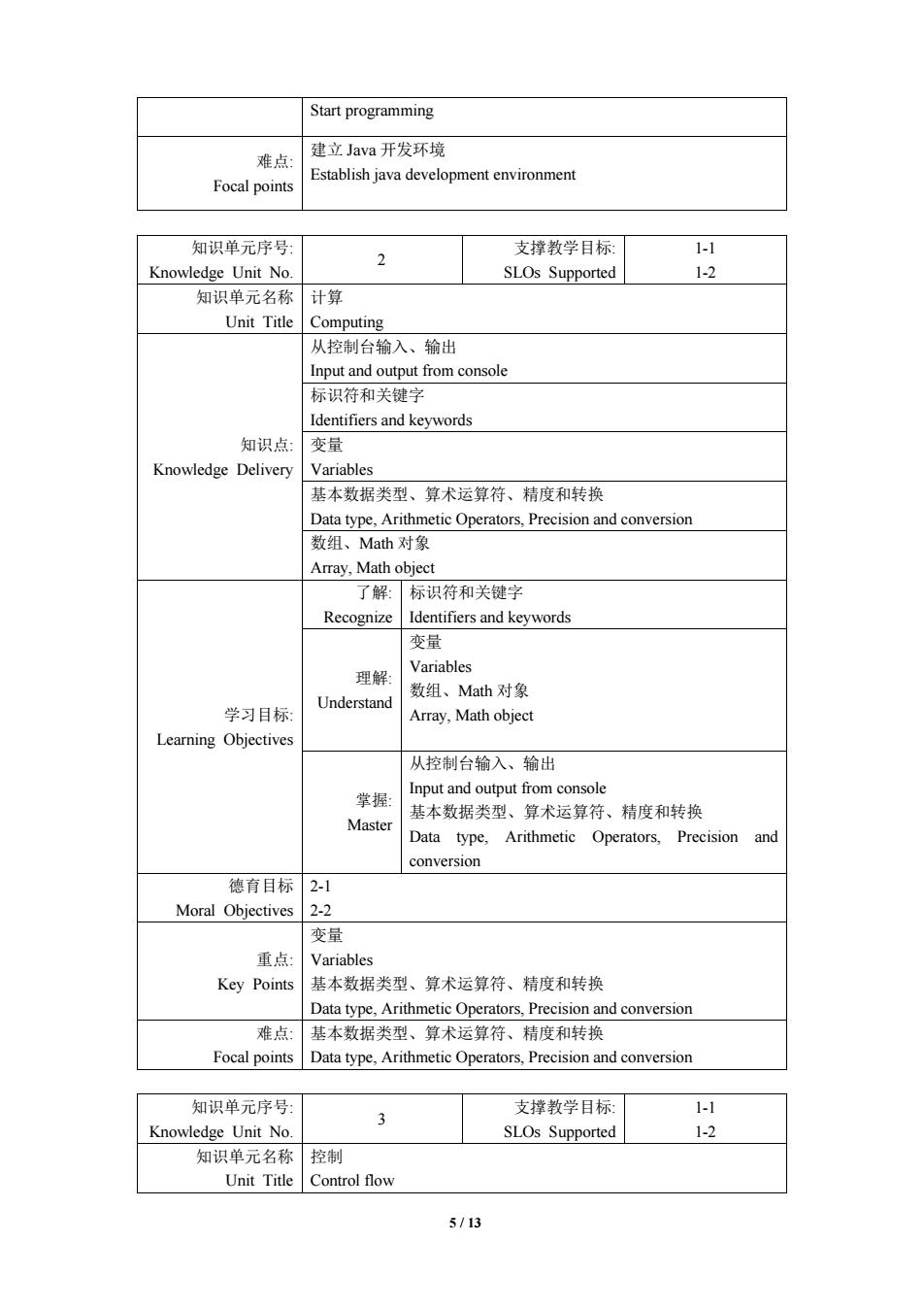
Start programming 难点 建立Java开发环境 Focal points Establish java development environment 知识单元序号: 支撑教学目标 1.1 Knowledge Unit No 2 SLOs Supported 1.2 知识单元名称计算 Unit Title Computing 从控制台输入、输出 Input and output from console 标识符和关键字 Identifiers and keywords 知识点: 变量 Knowledge Delivery Variables 基本数据类型、算术运算符、精度和转换 Data type,Arithmetic Operators,Precision and conversion 数组、Math对象 Array,Math object 了解标识符和关键字 Recognize ldentifiers and keywords 变量 Variables 理解 数组、Mah对象 学习目标 Understand Array,Math object Learning Objective 从控制台输入、输出 堂握 Input and output from console 基本数据类型、算术运算符、精度和转换 Master Data type,Arithmetic Operators,Precision and conversion 德育目标 Moral Objectives 2-2 变量 重点: variables Key Points 基本数据类型、算术运算符、精度和转换 Data type,Arithmetic Operators,Precision and conversion 难点:基本数据类型、算术运算符、精度和转换 Focal points Data type,Arithmetic Operators,Precision and conversion 知识单元序号 3 支撑教学目标! Knowledge Unit No. SLOs Supported 1-2 知识单元名称控制 Unit Title Control flow 5113
5 / 13 Start programming 难点: Focal points 建立 Java 开发环境 Establish java development environment 知识单元序号: Knowledge Unit No. 2 支撑教学目标: SLOs Supported 1-1 1-2 知识单元名称 Unit Title 计算 Computing 知识点: Knowledge Delivery 从控制台输入、输出 Input and output from console 标识符和关键字 Identifiers and keywords 变量 Variables 基本数据类型、算术运算符、精度和转换 Data type, Arithmetic Operators, Precision and conversion 数组、Math 对象 Array, Math object 学习目标: Learning Objectives 了解: Recognize 标识符和关键字 Identifiers and keywords 理解: Understand 变量 Variables 数组、Math 对象 Array, Math object 掌握: Master 从控制台输入、输出 Input and output from console 基本数据类型、算术运算符、精度和转换 Data type, Arithmetic Operators, Precision and conversion 德育目标 Moral Objectives 2-1 2-2 重点: Key Points 变量 Variables 基本数据类型、算术运算符、精度和转换 Data type, Arithmetic Operators, Precision and conversion 难点: Focal points 基本数据类型、算术运算符、精度和转换 Data type, Arithmetic Operators, Precision and conversion 知识单元序号: Knowledge Unit No. 3 支撑教学目标: SLOs Supported 1-1 1-2 知识单元名称 Unit Title 控制 Control flow
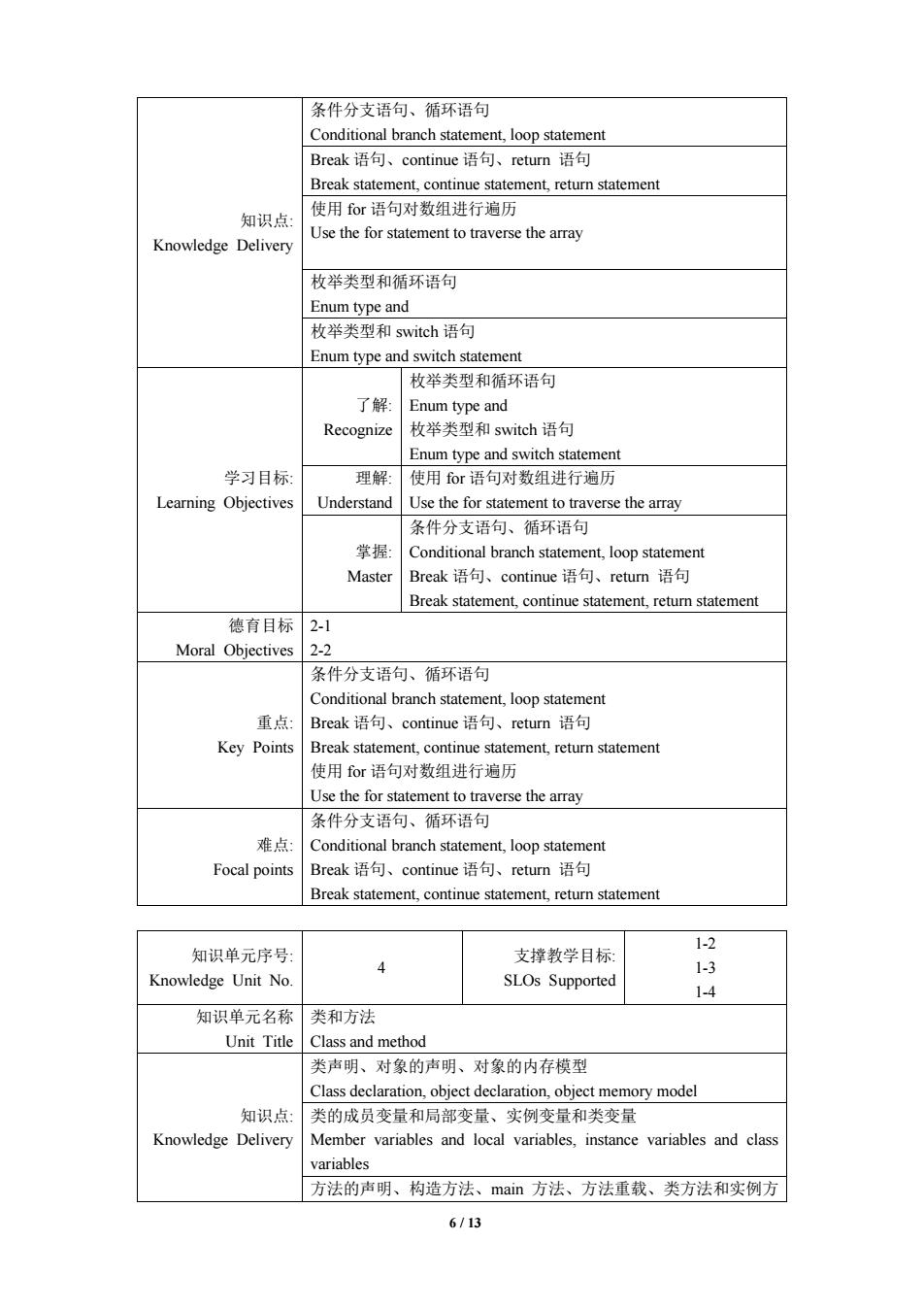
条件分支语句、循环语句 Conditional branch statement loon statement Break语句、continue语句、return语句 statement,cont nue statement,return statement 知识点: 使用for语句对数组进行遍历 Knowledge Delivery Use the for statement to traverse the array 枚举类型和循环语句 Enum type and 枚举类型和switch语句 Enum type and switch statement 枚举类型和循环语右 了解 type and Recognize 枚举类型和switch语句 Enum type and switch statement 学习目标 理解:使用for语句对数组进行遍历 Learning Objectives Understand Use the for statement to traverse the array 条件分支语句、循环语句 掌握 Conditional branch statement,loop statement Master Break语句、continue语句、return语句 Break statement.continue statement,return statement 德有目标 2-1 Moral Objectives 条件分支语句、循环语句 Conditional branch statement,loop statement 重占 Break语句、continue语句、return语句 Key Points .continue statement retun statement 使用for语句对数组进行遍历 Use the for statement to traverse the array 条件分支语句、循环语句 难点: Conditional branch statement.loop statement Focal points Break语句、continue语句、retur语句 Break statement return statement 知识单元序昌 支掉教学目标 1-2 1-3 Knowledge Unit No SLOs Supported 1-4 知识单元名称 类和方法 Unit Title Class and method 类声明、对象的声明、对象的内存模型 ory model 知识点 类的成员变量和局部变量 实例变量和类变 Knowledge Delivery Member variables and local variables,instance variables and class variables 方法的声明、构造方法、main方法、方法重载、类方法和实例方 6/13
6 / 13 知识点: Knowledge Delivery 条件分支语句、循环语句 Conditional branch statement, loop statement Break 语句、continue 语句、return 语句 Break statement, continue statement, return statement 使用 for 语句对数组进行遍历 Use the for statement to traverse the array 枚举类型和循环语句 Enum type and 枚举类型和 switch 语句 Enum type and switch statement 学习目标: Learning Objectives 了解: Recognize 枚举类型和循环语句 Enum type and 枚举类型和 switch 语句 Enum type and switch statement 理解: Understand 使用 for 语句对数组进行遍历 Use the for statement to traverse the array 掌握: Master 条件分支语句、循环语句 Conditional branch statement, loop statement Break 语句、continue 语句、return 语句 Break statement, continue statement, return statement 德育目标 Moral Objectives 2-1 2-2 重点: Key Points 条件分支语句、循环语句 Conditional branch statement, loop statement Break 语句、continue 语句、return 语句 Break statement, continue statement, return statement 使用 for 语句对数组进行遍历 Use the for statement to traverse the array 难点: Focal points 条件分支语句、循环语句 Conditional branch statement, loop statement Break 语句、continue 语句、return 语句 Break statement, continue statement, return statement 知识单元序号: Knowledge Unit No. 4 支撑教学目标: SLOs Supported 1-2 1-3 1-4 知识单元名称 Unit Title 类和方法 Class and method 知识点: Knowledge Delivery 类声明、对象的声明、对象的内存模型 Class declaration, object declaration, object memory model 类的成员变量和局部变量、实例变量和类变量 Member variables and local variables, instance variables and class variables 方法的声明、构造方法、main 方法、方法重载、类方法和实例方

法、参数传值:基本类型和引用类型 Method declaration,Constructor,main method,method overload,class method and instance method,parameter passing this关键字 keyword this 包、import语句、成员变量和方法的访问权限、类的访问权限、单 本模式 Package.import statement access rights of member variables and methods,access rights of class,single on mode 包、import语句、成员变量和方法的访问权限、类的 访问权限、单态模式 了解: Package,import statement,access rights of member Recognize variables and methods,access rights of class,singleton his关键字 keyword this 理解 类的成员变量和局部变量、实例变量和类变量 学习目标 Member variables and local variables.instance variable Learning Objectiv Understand and class variables 方法的声明、构造方法、main方法、方法重载、类 方法和实例方法、参数传值:基本类型和引用类型 Method declaration,Constructor,main method,method 掌掘 overload.class method and instance method.paramete Master 类声明、对象的声明、对象的内存模型 Class declaration,object declaration,object memory model 德育目标 2.1 Moral Objecti 方法的声明、构造方法、main方法、方法重载、类方法和实例方 重点 法、参数传值:基本类型和引用类型 Key Points Method declaration,Constructor,main method,method overload,class method and instance method,parameter passing 难点 对象的内存模型 Focal points object memory model 1-2 知识单元序县 支撑教学目标 Knowledge Unit No 5 SLOs Supported 1-4 知识单元名称继承和接口 Unit Title Interfaces and Inheritance 知识点 子类与父类的关系、子类的继承性、子类构建对象的过程 Knowledge Delivery The relationship between subclass and superclass,the inheritance of subclass,the process of constructing object by subelass 7113
7 / 13 法、参数传值:基本类型和引用类型 Method declaration, Constructor, main method, method overload, class method and instance method, parameter passing this 关键字 keyword this 包、import 语句、成员变量和方法的访问权限、类的访问权限、单 态模式 Package, import statement, access rights of member variables and methods, access rights of class, singleton mode 学习目标: Learning Objectives 了解: Recognize 包、import 语句、成员变量和方法的访问权限、类的 访问权限、单态模式 Package, import statement, access rights of member variables and methods, access rights of class, singleton mode this 关键字 keyword this 理解: Understand 类的成员变量和局部变量、实例变量和类变量 Member variables and local variables, instance variables and class variables 掌握: Master 方法的声明、构造方法、main 方法、方法重载、类 方法和实例方法、参数传值:基本类型和引用类型 Method declaration, Constructor, main method, method overload, class method and instance method, parameter passing 类声明、对象的声明、对象的内存模型 Class declaration, object declaration, object memory model 德育目标 Moral Objectives 2-1 2-2 重点: Key Points 方法的声明、构造方法、main 方法、方法重载、类方法和实例方 法、参数传值:基本类型和引用类型 Method declaration, Constructor, main method, method overload, class method and instance method, parameter passing 难点: Focal points 对象的内存模型 object memory model 知识单元序号: Knowledge Unit No. 5 支撑教学目标: SLOs Supported 1-2 1-3 1-4 知识单元名称 Unit Title 继承和接口 Interfaces and Inheritance 知识点: Knowledge Delivery 子类与父类的关系、子类的继承性、子类构建对象的过程 The relationship between subclass and superclass, the inheritance of subclass, the process of constructing object by subclass
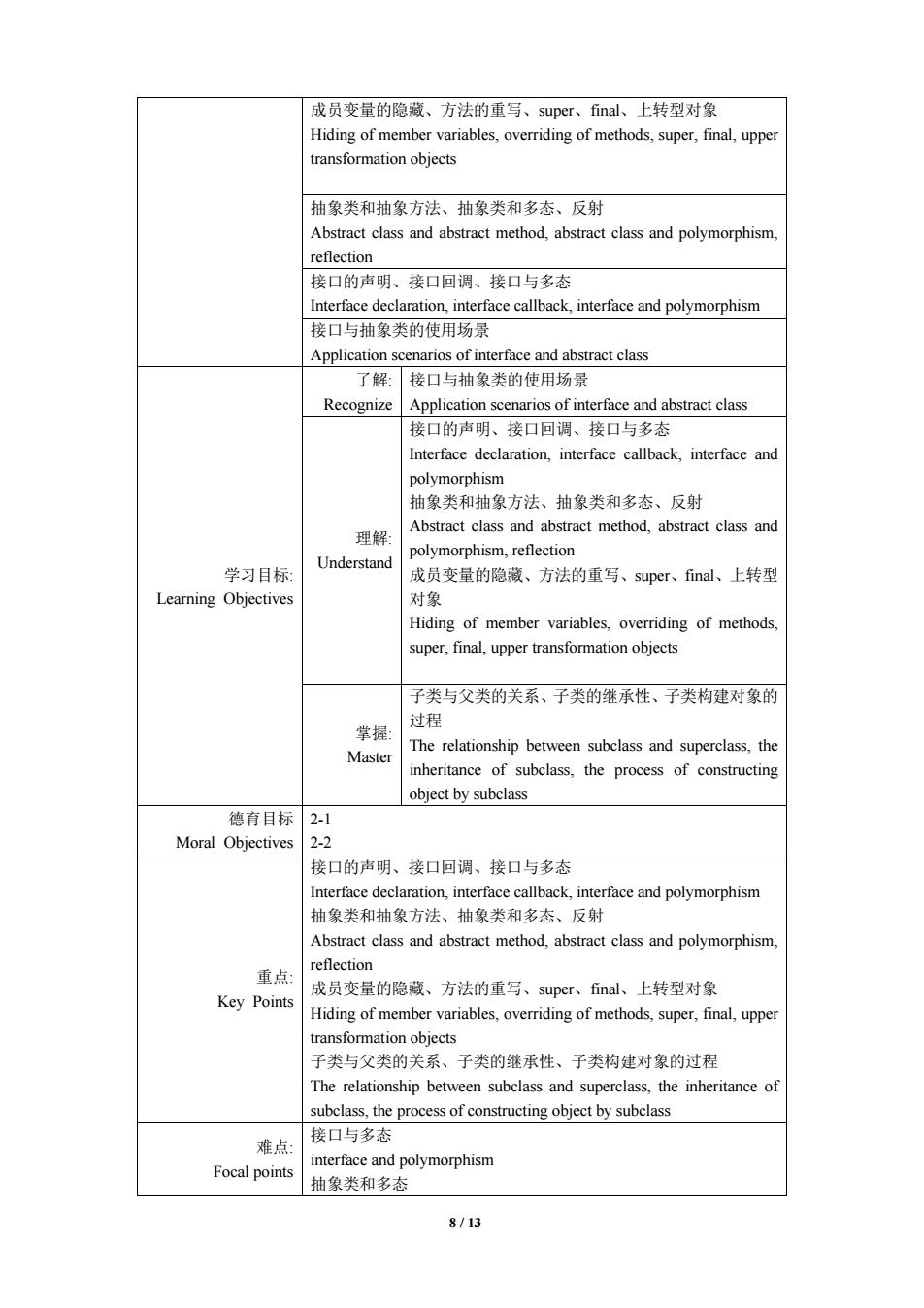
成员变量的隐藏、方法的重写、super、inal、上转型对象 Hiding of member variables,overriding of methods,super,final,uppe transformation objects 抽象类和抽象方法、抽象类和多态、反射 Abstract class and abstract method,abstract class and polymorphism reflection 接口的声明、接口回调、接口与多态 erface callback.interface and polymorphism 接口与抽象类的使用场景 Application scenarios of interface and abstract class 了解:接口与抽象类的使用场景 Recognize Application scenarios of interface and abstract class 接口的声明、接口回调、接口与多态 Interface declaration,interface callback,interface and oolymorphism 油象类和抽象方法、抽象类和多态、反射 理解 Abstract class and abstract method,abstract class and polymorphism, 学习目标 成员变量的隐藏、方法的重写、super、inal、上转型 Learning Objectives 对象 Hiding of member variables,overriding of methods uper,final,upper transformation objects 子类与父类的关系、子类的继承性、子类构建对象的 过程 掌握 Master The relationship between subclass and superclass.the inheritance of subclass,the proces of contructing object by subclass 德有目标 2- Moral Objectives 2-2 接口的声明、接口回调、接口与多态 Interface declaration,interface callback,interface and polymorphism 抽象类和抽象方法、抽象类和多态、反射 Abstract class and abstract method,abstract class and polymorphism reflection 重点 Key Points 成员变量的隐藏、方法的重写、super、inal、上转型对象 Hiding of member variables,overriding of methods,super,final,uppe 子类与父类的关系、子类的继承性、子类构建对象的过程 The relationship between subclass and superclass,the inheritance of subclass,the process of constructing object by subclass 接口与多态 Focal points eand polymorphism 抽象类和多态 8113
8 / 13 成员变量的隐藏、方法的重写、super、final、上转型对象 Hiding of member variables, overriding of methods, super, final, upper transformation objects 抽象类和抽象方法、抽象类和多态、反射 Abstract class and abstract method, abstract class and polymorphism, reflection 接口的声明、接口回调、接口与多态 Interface declaration, interface callback, interface and polymorphism 接口与抽象类的使用场景 Application scenarios of interface and abstract class 学习目标: Learning Objectives 了解: Recognize 接口与抽象类的使用场景 Application scenarios of interface and abstract class 理解: Understand 接口的声明、接口回调、接口与多态 Interface declaration, interface callback, interface and polymorphism 抽象类和抽象方法、抽象类和多态、反射 Abstract class and abstract method, abstract class and polymorphism, reflection 成员变量的隐藏、方法的重写、super、final、上转型 对象 Hiding of member variables, overriding of methods, super, final, upper transformation objects 掌握: Master 子类与父类的关系、子类的继承性、子类构建对象的 过程 The relationship between subclass and superclass, the inheritance of subclass, the process of constructing object by subclass 德育目标 Moral Objectives 2-1 2-2 重点: Key Points 接口的声明、接口回调、接口与多态 Interface declaration, interface callback, interface and polymorphism 抽象类和抽象方法、抽象类和多态、反射 Abstract class and abstract method, abstract class and polymorphism, reflection 成员变量的隐藏、方法的重写、super、final、上转型对象 Hiding of member variables, overriding of methods, super, final, upper transformation objects 子类与父类的关系、子类的继承性、子类构建对象的过程 The relationship between subclass and superclass, the inheritance of subclass, the process of constructing object by subclass 难点: Focal points 接口与多态 interface and polymorphism 抽象类和多态
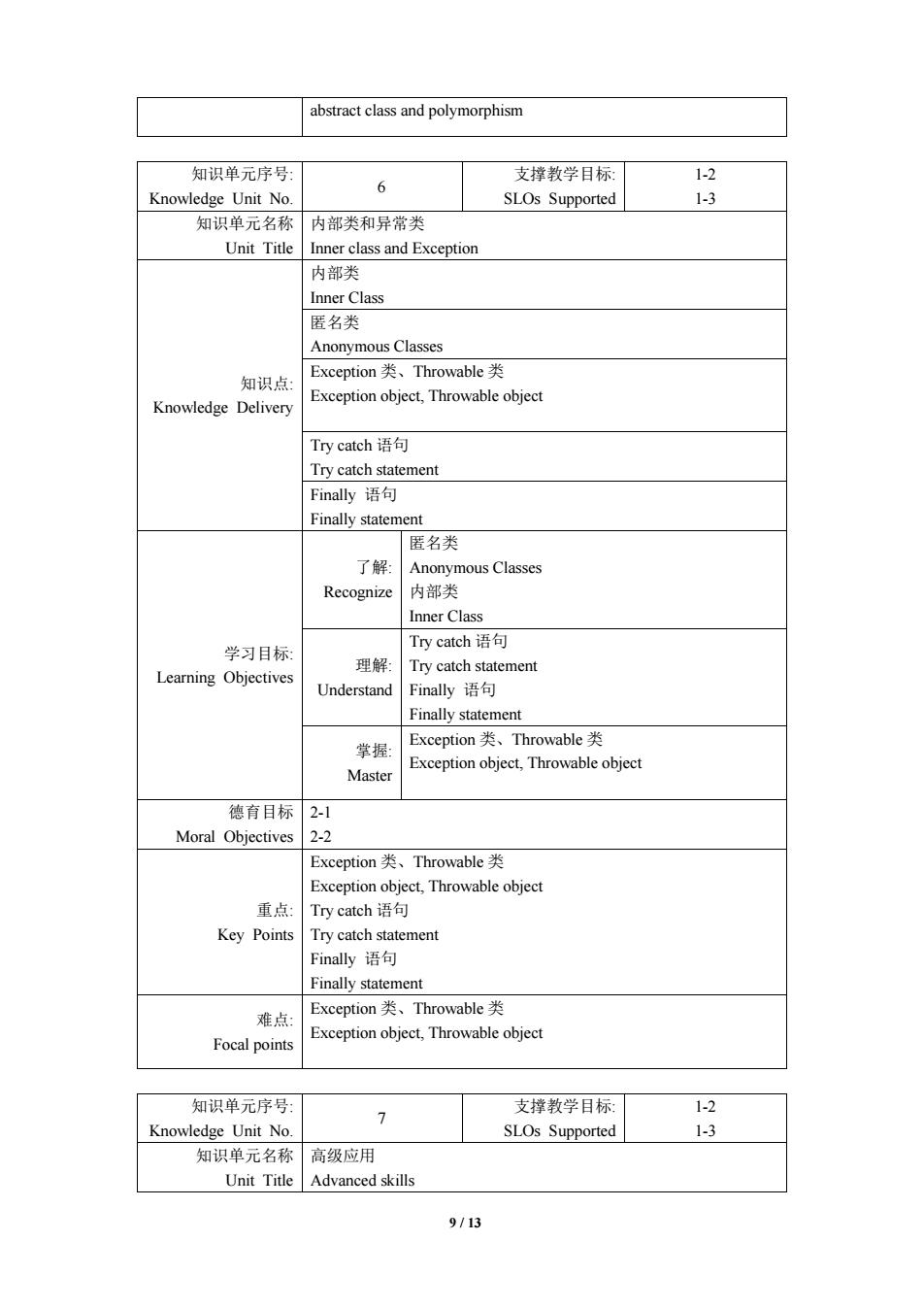
abstract class and polymorphism 知识单元序号 6 支撑教学目标 Knowledge Unit No. SLOs Supported 知识单元名称内部类和异常类 Unit Title Inner class and Exception 内部类 Inner Class 匿名类 Anonymous Classes 知识点 Exception类、Throwable类 Knowledge Delivery Exception object Throwable objec Try catch语句 Try catch statement Finally语句 Finally statement 匿名类 了解:Anonymous Classes Recognize内部类 Inner Class 学习目标 Try catch语句 Learning Objectives 理解:Try catch statement Understand Finally语句 Finally statement 掌握 Exception类、Throwable类 Exception object,Throwable object Master 德育目标2-1 Moral Objectives 2.2 Exception类、Throwable类 Exception object,Throwable object 重点 Try catch语句 Key Points Try catch statement Finally语句 Finally statemen 难点: Exception类、Throwable类 Focal points Exception object,Throwable object 知识单元序号 7 支撑教学目标 Knowledge Unit No. SLOs Supported 1-3 知识单元名称高级应用 Unit Title Advanced skills 9113
9 / 13 abstract class and polymorphism 知识单元序号: Knowledge Unit No. 6 支撑教学目标: SLOs Supported 1-2 1-3 知识单元名称 Unit Title 内部类和异常类 Inner class and Exception 知识点: Knowledge Delivery 内部类 Inner Class 匿名类 Anonymous Classes Exception 类、Throwable 类 Exception object, Throwable object Try catch 语句 Try catch statement Finally 语句 Finally statement 学习目标: Learning Objectives 了解: Recognize 匿名类 Anonymous Classes 内部类 Inner Class 理解: Understand Try catch 语句 Try catch statement Finally 语句 Finally statement 掌握: Master Exception 类、Throwable 类 Exception object, Throwable object 德育目标 Moral Objectives 2-1 2-2 重点: Key Points Exception 类、Throwable 类 Exception object, Throwable object Try catch 语句 Try catch statement Finally 语句 Finally statement 难点: Focal points Exception 类、Throwable 类 Exception object, Throwable object 知识单元序号: Knowledge Unit No. 7 支撑教学目标: SLOs Supported 1-2 1-3 知识单元名称 Unit Title 高级应用 Advanced skills
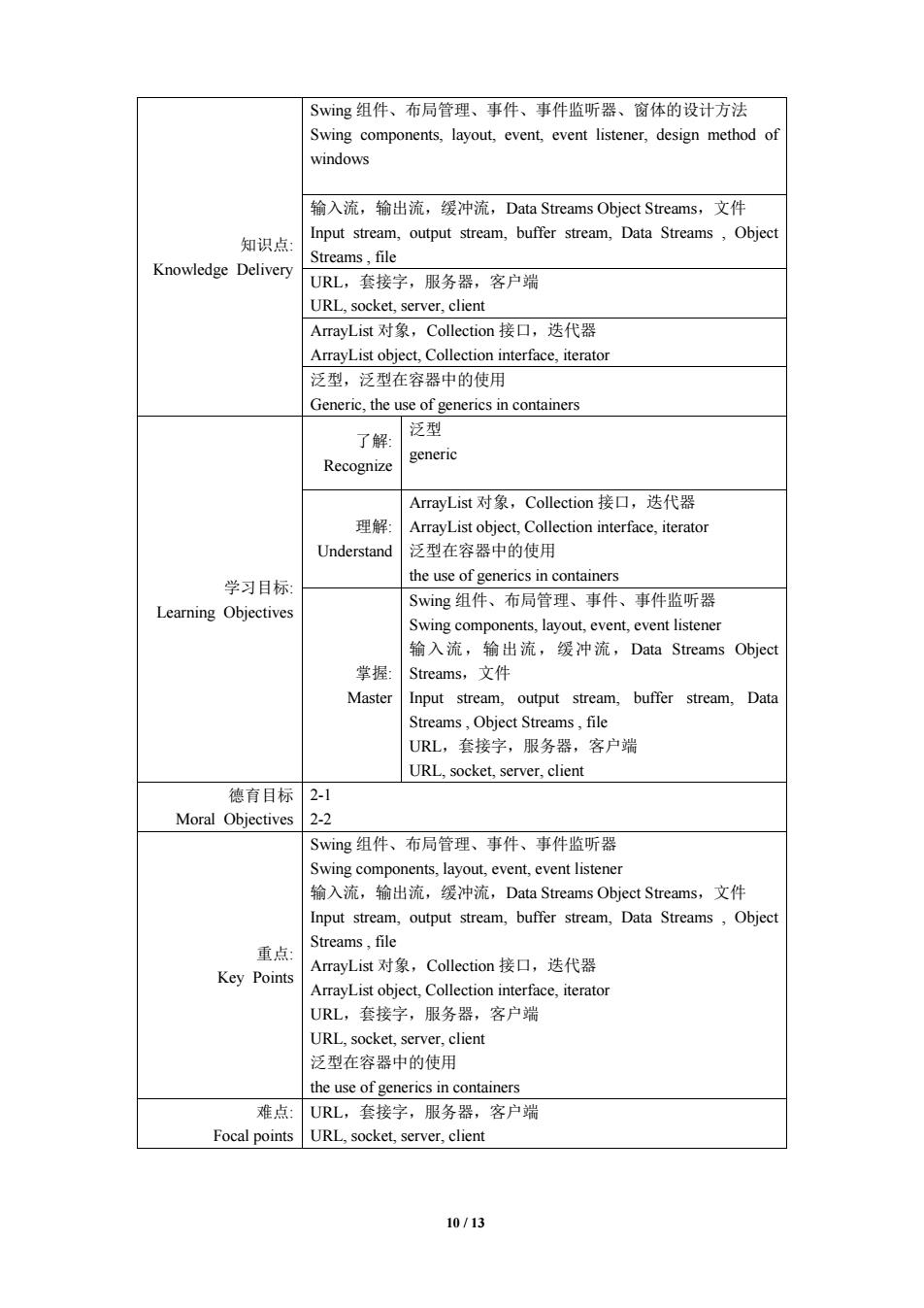
Svig组件、布局管理、事件、事件监听器、窗体的设计方法 Swing components,layout,event,event listener,design method of windows 输入流,输出流,缓冲流,Data Streams Object Streams,文件 知识点 Input stream,output stream,buffer stream,Data Streams,Object Knowledge Delivery Streams,file URL,套接字,服务器,客户端 URL.socl server.clien ArrayList对象,Collection接口,选代器 ArrayList object,Collection interface,iterator 泛型,泛型在容器中的使用 Generic,the use of generics in containers 了解泛型 Recognize generic ArrayList对象,Collection接口,迭代器 理解 ArrayList object,Collection interface,iterator Understand 泛型在容器中的使用 the use of generics in containers 学习目标 Swig组件、布局管理、事件、事件监听器 Learning Obiectives Swing components layout event event listener 输入流,输出流, 缓冲流,Data Streams Objec 掌握 Streams,文件 Master Input stream,output stream,buffer stream,Data Streams,Object Streams,file URL,套接字,服务器,客户端 URL,socket,server,client 德育目标 Moral Objectives 2-2 Swig组件、布局管理、事件、事件监听器 Swing components layout event event listener 输入流,输出流,缓冲流,Data Streams Object Streams,文件 Input stream,output stream,buffer stream,Data Streams,Objec Streams,file 重点 Key Points ArrayList对象,Collection接口,迭代器 ArrayList object,Collection interface,iterator URL,套接字,服务器,客户端 server,client 泛型在容器中的使用 the use of generics in containers 难点:URL,套接字,服务器,客户端 Focal points URLsocket,server,client 10113
10 / 13 知识点: Knowledge Delivery Swing 组件、布局管理、事件、事件监听器、窗体的设计方法 Swing components, layout, event, event listener, design method of windows 输入流,输出流,缓冲流,Data Streams Object Streams,文件 Input stream, output stream, buffer stream, Data Streams , Object Streams , file URL,套接字,服务器,客户端 URL, socket, server, client ArrayList 对象,Collection 接口,迭代器 ArrayList object, Collection interface, iterator 泛型,泛型在容器中的使用 Generic, the use of generics in containers 学习目标: Learning Objectives 了解: Recognize 泛型 generic 理解: Understand ArrayList 对象,Collection 接口,迭代器 ArrayList object, Collection interface, iterator 泛型在容器中的使用 the use of generics in containers 掌握: Master Swing 组件、布局管理、事件、事件监听器 Swing components, layout, event, event listener 输入流,输出流,缓冲流,Data Streams Object Streams,文件 Input stream, output stream, buffer stream, Data Streams , Object Streams , file URL,套接字,服务器,客户端 URL, socket, server, client 德育目标 Moral Objectives 2-1 2-2 重点: Key Points Swing 组件、布局管理、事件、事件监听器 Swing components, layout, event, event listener 输入流,输出流,缓冲流,Data Streams Object Streams,文件 Input stream, output stream, buffer stream, Data Streams , Object Streams , file ArrayList 对象,Collection 接口,迭代器 ArrayList object, Collection interface, iterator URL,套接字,服务器,客户端 URL, socket, server, client 泛型在容器中的使用 the use of generics in containers 难点: Focal points URL,套接字,服务器,客户端 URL, socket, server, client